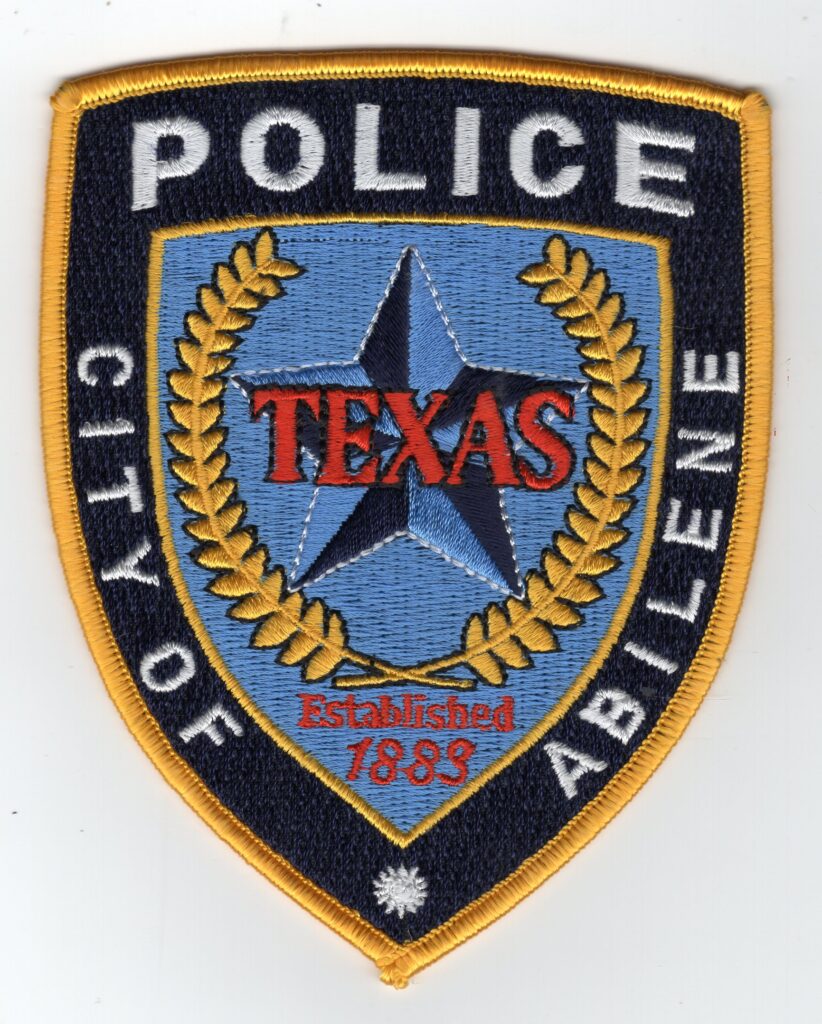The History of the Abilene Police Department Motorcycle Unit
I first met Motor Officers Mike Ricker and Rodney Holder in May of 1958 at the Law Enforcement Memorial at Hardin Simmons University. Since that time Mike has become a great friend and Rodney has gone to be with The Lord. Rodney died in a traffic accident in the 1300 block of Sayles on Thursday, April 29, 2010.
I would like to dedicate this page of Tales of the APD to the Memory of the Abilene Police Department Motor Officers who died in the line of duty and to all APD Motor Officers and members of the Traffic Division, past and present with special thanks to Motor Officer Mike Ricker for taking an old former Motor Officer under his wing,
Thanks to retired APD Officer Richard Valdez for providing a little help for me on the names of the current motor officers. I knew Mike Ricker and Terry Monroe. Mike had introduced all the guys to me at the most recent Law Enforcement Officer Memorial at Hardin Simmons University. I remembered that one of them was named, “Brian” as I asked him how he spelled it and learned that he spells his name wrong. (A private Joke) I knew Kelly Willis as I worked with his father and I thought Kelly was still riding a motor. My memory is getting short so Richard came to my rescue.
The current Motor Officers of the Abilene Police Department are Mike Ricker, Tyson Kropp, Brian Trail and Terry Monroe. Kelly Willis, a former motor officer is the hit and run investigator.
Background Information
I was born in January of 1933 in Abilene, Texas. When I was two or three years, my dad moved the family to Eastland, Texas for a short period of time, most likely not more than one or possibly two years. While in Eastland, he worked in a drug store owned by a member of the Vletas family (I think his first name was Spiro), well know in Abilene for candy making. The drug store had an old time soda fountain and a candy counter. I often visited my dad at work and a soda fountain and candy shop was heaven for a little boy. A service station near our house rented motorcycles. One day, my dad rented a motorcycle and we rode for several hours. That is when I became hooked on motorcycles. We lived near the court house where I often saw Police and Texas Highway Patrol motorcycles parked. I started drawing pictures of motorcycles.That is where the seeds of becoming a motor officer were planted. After we moved back to Abilene in 1938, I started watching my uncle J.T. “Bus” Wasson, C.A. Veteto and my childhood hero, J.D. Woodard riding Abilene Police motors, the dream really took off and started to grow.
I was born in January of 1933 in Abilene, Texas. When I was two or three years, my dad moved the family to Eastland, Texas for a short period of time, most likely not more than one or possibly two years. While in Eastland, he worked in a drug store owned by a member of the Vletas family (I think his first name was Spiro), well know in Abilene for candy making. The drug store had an old time soda fountain and a candy counter. I often visited my dad at work and a soda fountain and candy shop was heaven for a little boy. A service station near our house rented motorcycles. One day, my dad rented a motorcycle and we rode for several hours. That is when I became hooked on motorcycles. We lived near the court house where I often saw Police and Texas Highway Patrol motorcycles parked. I started drawing pictures of motorcycles.That is where the seeds of becoming a motor officer were planted. After we moved back to Abilene in 1938, I started watching my uncle J.T. “Bus” Wasson, C.A. Veteto and my childhood hero, J.D. Woodard riding Abilene Police motors, the dream really took off and started to grow. During my Junior High years, my uncle Roert Sterling lived with us. He owned a LaRay Powercycle which was made in France. It looked much like a Service Cycle or Simplex, but it had
a 20 inch wheel on the rear and a 26 inch wheel on the front. This made it a rather funny looking machine. I rode the LaRay for many, many miles. Next my dad purchased a used Salsbury motor scooter for me. The Salsbury was extremely big, heavy and awkard. I did not ride it very long before I became disgusted with it and sold it. My ownership of a real motorcycle, a 1942 Harley Davidson WLA military motorcycle did not occur until 1955 or 56.
My boyhood dream had been to become an Abilene Policed Officer, not just a police officer, but a motor officer. The Abilene Police Department was in my blood. My maternal grandmother had been a Rucker. She and Chief Ruck Sibley’s mother were sisters. Chief Sibley was named, William Rucker “Ruck”Sibley from the Rucker family name. He was a first cousin to my dad and his brothers, Clyde, J.T. “Buss” and Billy T. “Bill” Wasson. I always counted Ruck Sibley as Abilene’s 4th Chief of Police, but if you counted the City Marshal prior to Chief Clinton, he would have been the 5th Chief.
Motor Officers of the APD that I rode with:
During my time as an APD Motor Officer there was a slow, but constant turnover of officers who rode motors in Abilene. I therefore rode with many officers over that period of time. Some left the Traffic Division due to promotion, as did I. At least one left the Abilene Police Department for medical reasons. Some simply left law enforcement for other fields of endeavor. I hope I do not forget any names of these officers who rode the motorcycles of the Abilene Police Department. I must also note that many of the top ranks within the Department at that time were former motor officers.
At the time I joined the department, Captain C. A. Veteto, Traffic Captain, Day shift Sergeant F.M. Pruitt and Identification Officer, Lieutenant Grover Chronister were former motor officers. There was only one officer riding a solo motorcycle at that time. He was James Seaburn. He later left APD to become a U.S. Border Patrolman. Wayne Richardson who had previously ridden one of the solo motors was riding one of the two 3 wheelers at that time. Wayne and I became very good friends. He later left law enforcement. I think that E.L Brownlow was still riding the other 3 wheeler at the time, but it is possible that he could have already left the department. My dear friend J.C. Jones who was the first officer I ever worked with had also been both a solo and a 3 wheeler motor officer. I walked the Chestnut Street beat with J.C. Jones, my first night on the job as an APD Patrolman.
Over the years I rode with the following officers: Roy Solomon, Henry Graham, Wayne Richardson, Joe Taylor, Kenneth Hamil, Kenneth Bryant, Paul Angleton, Dwain Pyburn, Roy Brown, Ed Freeman, Scottie Stockton, Bill Roam and Don Price. There may have been others who have now escaped my ever fading memory. If so, to them and/or their families, I apologize.
It must be noted that some of the above were promoted to higher ranks within the department. Roy Solomon became a Detective. Bill Roam became a Sergeant. Scottie Stockton became a Sergeant then a Lieutenant. Paul Angleton and Dwayne Pyburn both became Assistant chiefs and Dwain Pyburn later became Chief of Police.
Motorcycle Fleet in 1954
At the time I joined the APD in 1954 the Department owned four motorcycles and was operating three of them. The motorcycle fleet consisted of an old gray colored Indian chief (80 cubic inch engine) and a black 1952 or 53 Harley Davidson FL Hydra-glide (74 cubic inch engine) and two black Harley Davidson Servi-cars (3 wheelers with 45 cubic inch engines). The old red 3 wheeler that I mentioned in my Memory Lane
page on this website had been transferred from the Police Department to the Parking Meter Department.
The only solo motor that was being operated at the time was ridding by James Seaburn. I believe that Wayne Richardson was riding one of the 3 wheelers at the time and possibly E. L. Brownlow was riding the other, however I am not sure. Previously Wayne Richardson had ridden the FL Hydra-glide. By the time I had been moved to the evening shift (3:00PM to 11:00PM) Henry Graham was riding the Indian, James Seaburn had resigned to join the U.S. Border Patrol and Roy Solomon was riding the Harley solo. Wayne Richardson was riding one of the 3 wheelers and O.R. Spross was riding the other. At the end of my tenure as a Motor Officer, the Fleet had increased to 10 motorcycles. The accident that laid me up for three months with noting to do but study; resulting in my promotion to Sergeant reduced the motorcycle fleet to 9 motorcycles.
In the early days of the Abilene Police Department, officers who rode motorcycles were known as Traffic Officers. My desire to be an Abilene Police Department Motor Officer was based upon two factors. The first was that my uncle, J.T. “Bus” Wasson had been a Traffic Officer. I doubt that anyone in the 1930s and 40s ever dreamed that in some Police Departments of the future there would be Reserve Officers. He was what at the time was known as a Relief Officer. This was as close as it could be to today’s Reserve Officers. He was a riding partner of C.A. Veteto and J.D. Woodard. The second factor was my boyhood hero, Abilene Traffic Officer J.D. Woodard. I would often stand on the sidewalk where I would wait and watch for J.D. Woodard to ride by. J.D. Woodard would work his way through the ranks of the Abilene Police Department to Captain. He would later work as a Deputy Sheriff and a Deputy Constable. He would later be elected Constable then elected Sheriff of Taylor County.
My Dream Come True
My life long dream had been to become an Abilene Motor Officer. When that dream did come true, I really got off to a bad start. I did not report for work the first day that I was to start my new job as a Motor Officer. It was 1955 and I was now working the evening shift. I had already put in my request to be assigned to the Traffic Division as a Motor Officer. One day when I entered the Police Station, I met Captain Veteto (Traffic Captain) in the hallway. He said, “You are being assigned to ride a three wheeler. I was excited. I really wanted to ride a solo motor, but a 3 wheeler was fine with me. I may have been so excited that I forgot to ask when? It was more like I was still in a military mindset. In the military you are often told that you will be assigned to do something, but you wait until you receive orders with the effective date. I guess I thought he meant this would be in the future and that I would be told the when. The next day when I came into the Police Station about 2:30Pm for the evening shift, I was again met by Captain Veteto. He said, “I thought you wanted to ride a motorcycle.” I responded, “I do.” He then said, you were supposed to report for duty at 7:30AM today.” I apologized for my misunderstanding and assured him that I was ready to ride.” The next morning I was at the Police before 7:00AM and before 7:30AM, I was out on the ramp cranking that motorcycle for my first day on the job I had dreamed of all my life.
The primary responsibility of the officers mounted on the two 3 wheelers was working traffic in the downtown business district. We also answered other calls in the downtown area. If an arrest was made, we called a patrol car. We kept unauthorized vehicles from parking in the alleys. Parking in alleys was limited to commercial vehicles making deliveries. We kept cars from double parking. We assisted the officers walking the beats when requested. There were Meter Maids working the parking meters, but we assisted them when necessary. If there were parking violations other than over parking, we wrote those tickets. Abilene had a very strictly enforced ordinance that made it illegal to make a left turn into or out of an alley or private driveway in a business district. We also assisted the solo motors in escorting funerals when requested. As Abilene only operated a total of four motors at that time, on occasion there were more funerals in a single day than the two solo motors could escort. In such case, we would leave the downtown area and make funeral escorts. Due to the fact that the 3 wheelers did not have as much speed and power as the solos, we would just get in front of the procession and lead it. We did ride left of the center stripe and had much more maneuverability than a patrol car leading a procession. It was difficult for a patrol car to lead a procession while left of the center stripe. If there was an extremely long procession, one of the 3 wheelers would assist the solo motors by bring up the rear on the left of the center stripe to keep cars from passing the procession. The extra width of the 3 wheeler made it ideal for this job.
My partner at the time that I started riding a 3 wheeler was my good friend Wayne Richardson a former solo rider. Wayne can be seen mounted on the black Harley on page 47 of the book, Gunfire on South Front. When Wayne resigned from the Abilene Police Department to make more money in the private sector, he was replaced on the 3 wheeler by Shelby Fancher.
The 3 wheelers had two very important advantages over the solo motorcycles. First and most important was two way communications. A six volt car battery and the same type two way radios that were mounted in the trunks of patrol cars were mounted in the box of the three wheelers. The solo motorcycles only had receivers. I will address solo motorcycle radios in more detail later.
The second was storage space. At that time the solo motors did not have saddle bags or luggage racks. They had very little space to carry supplies and no place for jackets, and rain suits. The officers who rode solos bolted heavy duty spring clips on each side of the windshield. A ticket book was carried in one clip and an accident investigation book was clipped in the other. (At that time the APD had books that contained all the information necessary to complete an accident report. This information could later be copied into an accident report form.) There was a slight inward curve at the bottom of the windshield of the Harley solo motorcycles. This made a perfect place to carry what we called, “blue forms” in a roll held by rubber bands. (At that time the drivers involved in traffic accidents were required to complete an accident report and send it to DPS. These reports were printed on blue paper and thus were referred to as, “Blue Forms.” This was the extent of storage space on the solo motorcycles at that time.
The 3 wheelers on the other hand, had an abundance of storage space. Heavy cardboard boxes were placed in the motorcycle box alongside the radio in order to keep supplies away from the battery. Such things as rain gear, jacket, accident reports and extra ticket books could be easily transported.
I knew that the motor, I was riding was the oldest in the fleet. I did not know that a new replacement had already been ordered for it. In fact two replacement 3 wheelers were on order. The other was a replacement for the old red 3 wheeler that had been transferred to the Parking Meter Department and mentioned in the “
Memory Lane ” page of this website. The Parking Meter Department used the 3 wheeler to collect money from parking meters and to transport meter heads to the shop for repair.
It was not long before two bright, shiny black Harley Davidson Servi-Car motorcycles arrived at Jack Johnson’s Harley Davidson dealership. At first sight, they appeared to be identical, but there
were slight variations. The police motor that was destined to be assigned to me had a larger, higher amp generator, a light bar with two red lights and a siren powered by the left rear wheel and activated with a heel operated lever. This was the first 3 wheeler specifically equipped for police work that the Abilene Police Department had ever purchased.
I was very proud of this new 3 wheeler. I kept a heavy coat of wax on it at all times. I even purchased a special treated cloth to keep dust wiped off of it at ever opportunity. I do not remember the date I got this new motor, but Shirley and I were married on February 4, 1956. I was still riding it at that time. I believe I rode it until about March of 1956. Roy Solomon and Henry Graham were riding the two solos at that time. Roy Solomon was promoted to Detective. I asked Captain Veteto for the vacant solo and my request was granted.
Before I go too far with the story about moving over to the vacant solo motor, I need to back up a bit to the first motorcycle that I owned while I was still riding the 3 wheeler. It nearly caused a divorce between newly weds.
Looking Back – My First Motorcycle
By J. Bryan Wasson
It was a motorcycle that caused me to meet my wife, Shirley. I was a Motor Officer with the Abilene, TexasPolice Department at the time we met. It was also a motorcycle that came close to ending a very short marriage.
There is no doubt in my mind that the happiest period in my life as a law enforcement officer was the five years that I rode a motorcycle in the Traffic Division of the Abilene Police Department. I was on duty from the time I stepped out of the house in the morning and through my leg over that motorcycle until I got off the motorcycle at my home at the end of my shift. Can you imagine, getting paid to do what you loved to do most? Therein is the problem.
I did not own a motorcycle when Shirley and I first got married; I just rode a motorcycle owned by the Abilene Police Department for eight hours per day. Soon after we were married, I purchased my first motorcycle, a 1942 Harley Davidson WLA, U.S. Army surplus motorcycle in near mint condition. The Motor Officers rotated shifts. Some of us went in early for the early morning traffic. Some came in later and stayed on duty until the 5:00PMtraffic rush was over.
Shirley was working at the S&H Green Stamp Store. She did not get off until 5:00PM or after. On the days that I worked the early shift, I would be home by 3:30PM. I would park my Police motorcycle, run up the stairs of our garage apartment, change out of my uniform and then back down the stairs. I would then mount my own personal motorcycle and be gone again. I would ride until about 9:00PM and then come home.
Now back to the story. I had been assigned to the oldest 3 wheeler we had and it had been replaced with a new one now I was assigned to the oldest solo motor in the fleet. I was unaware of it, but a new replacement for it had already been ordered. Within a 12 month period or less, I had two brand new motorcycles assigned to me.
By the time I was transferred to a solo, at least two other solos had been added to the fleet. Chief W.B. “Red” McDonald loved motorcycles. He kept adding to the motorcycle fleet. First he purchased one additional solo motor, bring the fleet to two 3 wheelers and 3 solos. He added aditional motors until we had a total of eight and then ten motorcycles. Chief McDonald did some research and determined that eight motorcycles working day shift only wrote double the amount of traffic tickets as all the cars working all three shifts.
Some of our Harleys were FLs and some were FLHs. This is a designation given by Harley-Davidson. I could not tell the difference, but I am sure there were slight variations that a Harley-Davidson expert could tell.
I think most modern day police officers feel rather lost with out two way communication. Now most officers have a”walkie-talkie” attached to their belt with a mic attached to the epaulet of their shirt. This was not the case in 1956 riding a solo motorcycle for the Abilene Police Department.
There was a red button on the console of the base station radio at headquarters that was pushed by the radio operator prior to transmitting to the solo motorcycles. This transmitted a tone. This was followed by a broadcast of, “Headquarters to Motor One (or Motor two.” I was now riding motor one. If you heard that tone followed by a broadcast to your motor number, you headed for the nearest telephone where you made a call to determine the assignment.
The reason the solo motors only had receivers was the fact that the radios were tube type. Tube type radios took more electricity to operate than transistor radios. The electrical system on solo motorcycles in those days would not support two way radios. I guess it could have been worse. If you look at the motorcycles on page 29 in Gunfire on South Front, you will note that they have no radios at all, not even a receiver.
I did not ride this solo motor very long until a brand new 1956 Harley FL (74 cubic inch) came in to replace it. Along with the new motorcycle came new 2-way transistor radios for my motorcycle as well as one or two more. (I think these radios may have been partially transistorized and partially tube, but I am not sure.)
These radios were rubber mounted to absorb shock inside steel boxes. The boxes were mounted in a frame on each side of the rear fender. Two steel bars went over the rear fender connecting the two frames. I went to the man at the City Barn who did the welding and asked him if he could build a luggage rack and weld it to these two steel bars that went over the rear fender. It did not take him long to build and attach the luggage rack. (Note side mounted radios in photos above along with the luggage rack above the rear fender.) This gave me a place to tie a jacket, rain gear etc. As soon as the other motor officers saw my luggage rack, they all wanted them. In an emergency, a person could even ride on these racks and I believe that on more than one occasion this occurred.
When we got our first Duo-Glydes, they came with saddle bags. Some new radios were received that were designed for motors with saddle bags. These radios were fully transistorized and top mounted above the rear finder. There were more new motorcycles, however, than new radios. It had been determined by top management that to save money, all our old side mount radios would be used. I was going to get a motor with saddle bags, but for which no new radio had been ordered. It appeared that there was no way to mount our old side mount radios on the new motors with saddle bags. I had seen photos of side mount radios placed inside the saddle bags, but I sure did not want that. The advantage of having saddle bags would be lost.
The Radio Shop that was taking care of City of Abilene radios was Arnold 2 Way Radio, owned by a former Abilene Police Captain. I went to the radio shop and talked to Captain Arnold (I can no longer his first name) about a method to mount the old sided mount radios. I asked him if they could be turned over on their sides with the lids facing outward and mounted on the same type of mounting bracket as the new top mount radios. He said that it would work, however with the boxes on their sides rather than up right, there was a possibility of water getting inside the boxes. It was necessary to drill some new holes in the boxes and close some of the old mounting holes with solder. We measured one of the boxes for the new top mount radios as well as the old side mount radio boxes. We found that with the old side mount boxes on their side, the measurements of the two side mount boxes and the new top mount boxes were nearly the same. I went to an upholstery shop and had them make a black waterproof cover that fit over the two boxes. Not only did this take care of the water problem, it was also cosmetic in that the cover made the two boxes look like a single unit. At least two and possibly three motorcycles wound up with the old side mount radios mounted as if they were top mount radios.
Some of our motors had rear mounted sirens that were powered from the rear wheel and operated with a heel lever just behind the left footboard. Some had sirens mounted on the front fender that were powered by the front wheel and operated by a lever mounted on the handlebars. I did not like the front mounted sirens as well. There was a little vibration on the front wheel at high speeds with the siren engaged. Holding the trigger like lever to keep the siren engaged was uncomfortable and they were not near as loud as the rear mounted sirens due to the much smaller size.
As evidenced by old photos, APD motor officers had previously worn riding breeches and boots. My uncle, J. T. “Bus” Wasson had worn riding breeches. He wore leather leggings with rubber soled brogan shoes. These leather leggings had a name, but I no longer remember what they were called. They were still listed in Police uniform and equipment catalogs as late as the 1950s. If these leather leggings are still made, I do not know.
At the time I joined the APD this was not the case. Motor officers were wearing regular uniform trousers. Soon after, I became a motor officer; however, the Department started issuing us riding breeches. This was a gradual phase in. I think we were issued only one pair (possibly two) at first. Therefore an officer might be wearing riding breeches one day and regular uniform trousers the next. I went to a local tailor and had an extra pair of riding breeches made at my own expense.
All officers were measured for new uniforms two times per year. During the summer we were measured for winter uniforms and during the winter we were measured for summer uniforms. Over time each officer developed a surplus of uniforms. The oldest were turned in and placed in the uniform closet. At the time I went to work winter shirts were dark navy blue wool and trousers were of the same material. The summer shirts were gray poplin with the trousers being dark navy blue, but a lighter weight material than the winter trouser. There came a time when many officers declined to be measured for new uniforms due to the surplus. It was through this regular twice per year measuring for new uniforms that motor officers gradually obtained sufficient riding breeches. If a motor officer resigned, you could find motor officers in the uniform closet rummaging around looking for riding breeches.
Although riding breeches were issued, boots were another thing. The City did not issue boots at the time. Officers had to furnish their own. I owned a pair of Wellington boots that I had worn before I was assigned to ride a motor. I took them to Mr. Pumphery, a local boot maker who had a shop on Pine Street in the Windsor Hotel building. He sewed a tall top on them for me. I was not completely satisfied with these boots. I next purchased two pair of English Riding boots. They
were $25.00 per pair, an extremely high price at that time on a police officer’s pay. It would be nice if such boots could be purchased for $25.00 per pair today. These boots had leather soles, not safe for motorcycle riding. The normal way to put half soles on shoes or boots is to cut the old soles at the shank before removing them. Next the new half soles would be skived to fit in with the old sole at the shank. I had different plans for my new riding boots. I took them to Mr. Pumphery and had him to put rubber half soles on the new boots without cutting out the leather soles. He put the rubber half soles right on top of the leather soles making the soles twice as thick. This extra thick sole came in handy on the hot Texas summer asphalt streets. I rotated these boots every other day and kept a “spit shine” on them at all times.
I suspect that it was about 1958 or 59 that the Police Department started issuing hand made boots to motor officers. We were all sent to Pumphery’s boot shop. He measured each officer and made boots for us. The boots were actually round towed cowboy boots with a walking heel. They were of excellent quality. I do not remember the height of the tops, but I thought they were a little bit too short for riding breeches. I asked Mr. Pumphery to make the tops on my boots one inch taller than the other boots. He complied with my request.
Our duties were many. One of our primary duties was escorting funerals. This was very good public relations for the Police Department. Families of the deceased remembered and appreciated these escorts. Many Police Departments today have stopped escorting funerals and many now charge for funeral escorts. Many departments now use cars for funeral escorts rather than motorcycles. It is extremely difficult for a proper funeral escort to be made with a patrol car.
The first solo rider to arrive at work in the mornings would call all the funeral homes and make out a Funeral Assignment sheet. The funeral homes always had a pretty good idea how large a funeral would be. The average funeral was escorted with two motorcycles. Smaller funerals could be handled with one motorcycle. A large funeral could take three or more motorcycles. Sometimes it was necessary to assign a 3 wheeler to a funeral.
A funeral escort started by picking up the family at a residence and escorting to a church or to a funeral home chapel. All the funeral homes except one had a room equipped with a speaker where officers could wait during the funeral. The speaker allowed officers to know when the service was near the end at which time they would go out and wait by their motorcycles.
Funeral processions were escorted using a leap frog method. We always rode slightly to the left of the center stripe. This caused oncoming traffic to pull to the side and stop. If two motors were used, one officer pulled into the intersection stopping cross traffic as well as oncoming traffic. The second officer would pass the first officer in the intersection and ride to the next intersection stopping cross and oncoming traffic. The longer the procession was or the closer the intersections were together made it necessary to ride faster. If three or four solo motors were escorting a procession, the second and third motors would pull into an intersection and relieve the officer in front of them rather than leapfrogging as the first two motors did. It is possible to leapfrog all four motors, but it is too dangerous. The lead rider was always on the alert for danger in order to warn the officers coming up from behind at a high rate of speed. The most dangerous riding we did was escorting funerals.
It was no more than two days after I was issued my brand new hand made boots made by Mr. Pumphry that I was involved in an accident the story of which which contained bits of humor.
We had two major duties, accident investigation and funeral escorts. The most dangerous riding that we did was while escorting funerals. It was more dangerous than high speed chases. I will discuss that more at a later point. There were other escorts also. During the tie period that all the Atlas missiles were located throughout the Big Country, we escorted a lot of liquid oxygen. We received special training at Dyess Air force Base related to the liquid oxygen. It is extremely dangerous material. These were not high speed escorts. The purpose was to get the tankers safely to their destination without accidents.
Writers Notes: I grew up watching the motorcycles of the Abilene Police Department. Due to the fact that 3 wheelers as they were referred to by the officers were part of the fleet of motors of the APD from my earliest childhood memories through most of my tenure at the APD, I have decided to include these notes related to the 3 wheeled motorcycles of the Abilene Police Department as well as a little bit of the history of these vehicles.
The Harley-Davidson Servi-Car was a three-wheeled motorcycle manufactured from 1932 to 1973. In 1958 the spring forks were replaced with Hydra-Glyde forks. At some point after that, a more modern, rounded diesign fiberglass one piece box and rear fenders replaced the steel box and rear fenders.
The Harley-Davidson Servi-Car derived its’ name from the fact that it was first targeted at the automotive service industry. The vehicle was designed to be towed behind a car when delivered to a customer; when the car was delivered at its destination, the driver would unhitch the Servi-Car from the rear bumper of the car and ride back to the garage on the motorcycle. Servi-Cars used for this purpose were equiped with a tow bar and a large 60 amp battery in order to jump start cars. When I was growing up, nearly every service station and automotive garage in Abilene had one of these 3 wheeled motorcycles.
Before parking meters came into being, in order for more customers to be able to patronize the store of their choice; it became necessary to limit the amount of time that cars were allowed to park in downtown business areas. Police departments learned that these three wheeled motorcycles were extremely useful for that purpose. An officer would ride slowly along and mark the tires of parked cars using a special long pole with a piece of chalk attached to the end. They were also extremely valuable in working traffic and for accident investigation in downtown business districts. They could turn around on a dime and could be driven at extremely slow speeds. Solo motorcycles could not do this.
In 1986, while I was working for the U.S. Department of Transportation in South Carolina, a motorcycle dealer told me that The California Highway Patrol had contracted with Harley Davidson for a special production run for some Harley Davidson Servi-Cars. He also indicated that the Columbia, SC Police Department might have acquired some of this special run of Servi-Cars. I could never determine for exactly what use the California Highway Patrol would use three wheelers, but have confirmed that this organization did in fact use some Servi-Cars. The photo that I found was no different than any other such motorcycles that I had seen. As it turned out the Columbia, SC PD was using some Harley Davidson three wheelers, but not like any I had ever seen before. I remember that they were shorter and had foot pegs rather than footboards. I believe that they may have been built much like a Harley Sportster. I have never seen such motorcycles before or after. These three wheelers were put up for sale and replaced with some type of small jeep like vehicle that had a bad reputation for turning over. The Columbia Police Chief caught a little flack in the newspapers over this move.
During my time in Columbia, SC, the Police Department had ceased to use any solo motorcycles for normal duty. Evidently, however, they had retained some black and white motors for funeral escort duty. These motors were ridden by off duty officers. It is possible that some officers had purchased these motors from the city for off duty funeral escorts.
It should also be noted that Indian also produced a three wheeled motorcycle known as a Dispatch Tow. In the past the Abilene Police Department owned at least one Indian 3 wheeler.
It should be noted that some of the motor officers switched back and forth between solo and 3 wheeled motorcycles. Some claimed that they could not guide the three wheelers and some thought the 3 wheelers to be beneath their dignity. When I became a motor officer, I was among those who switched back and forth. Joe Taylor and Shelby Fancher were officers who could ride a 3 wheeler one day and a solo the next. I once saw Joe Taylor do a “wheelie” on a three wheeler. I would not attempt that. I thought the 3 wheelers were a lot of fun. Trikes, as they are now known have become extremely popular today.
I still believe that in some municipalities today there are locations where a three wheeled motorcycle would be of value in law enforcement.
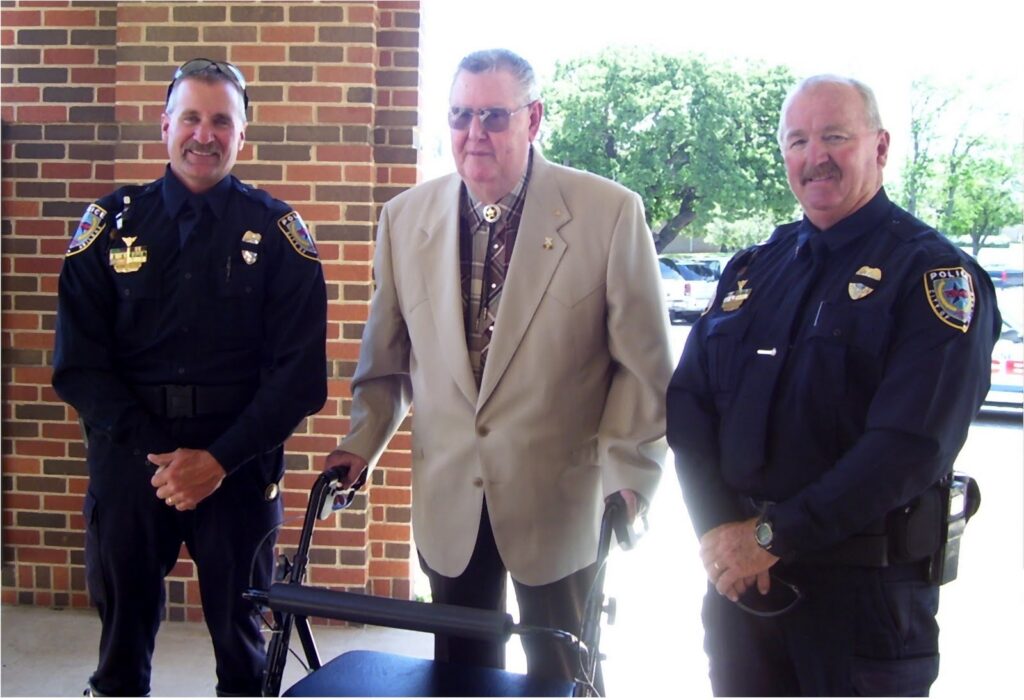
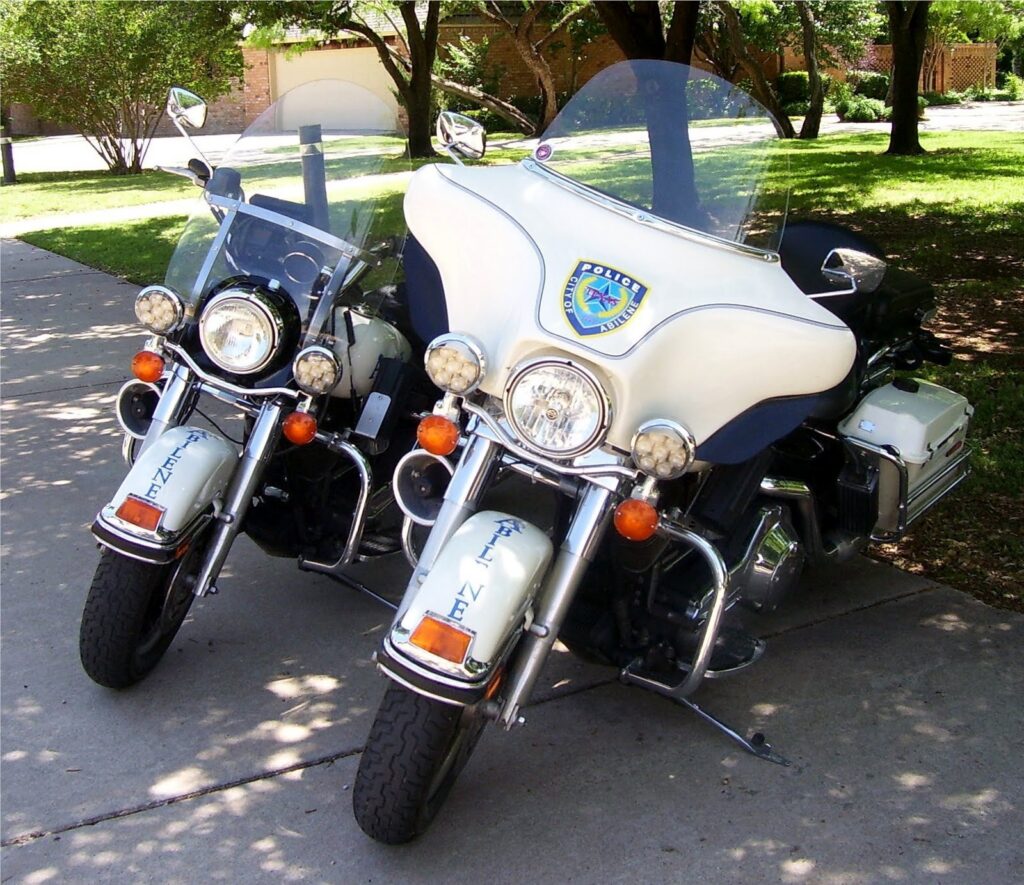
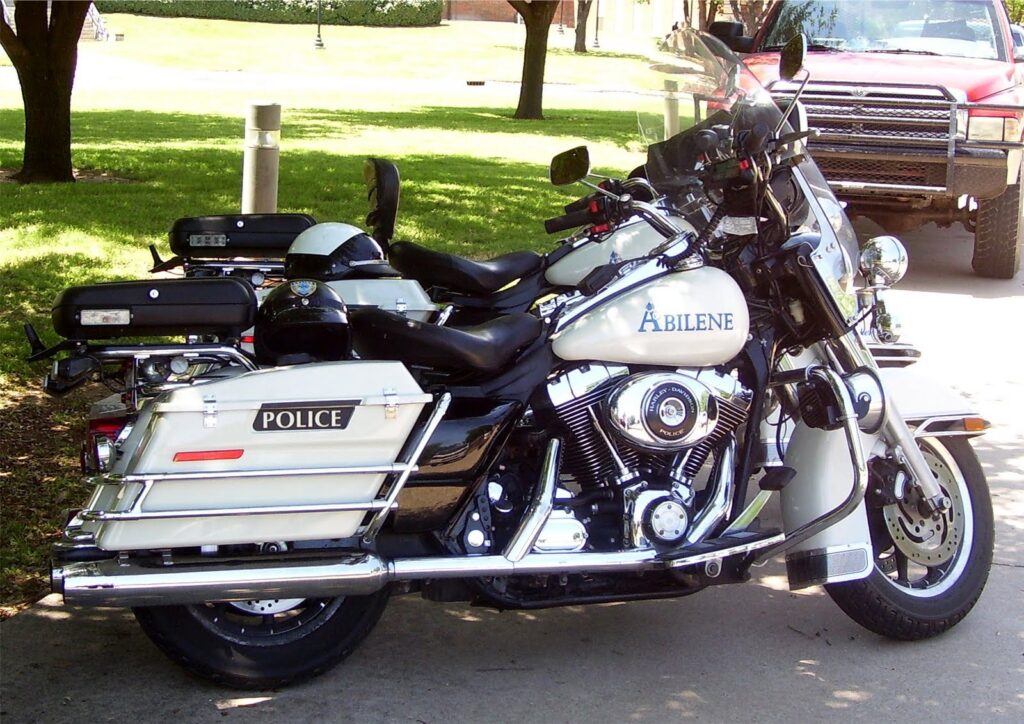
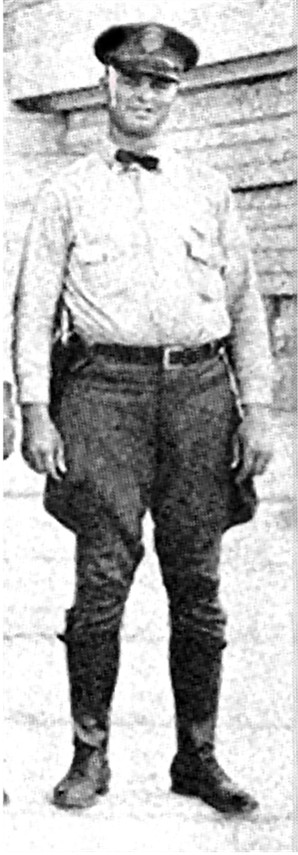
Died in the line of duty: Sunday, December 14, 1930
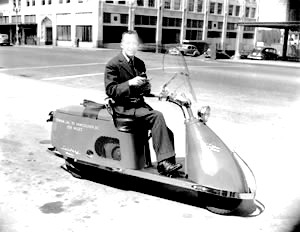
Salsbury Motor Scooter. They were long and heavy.
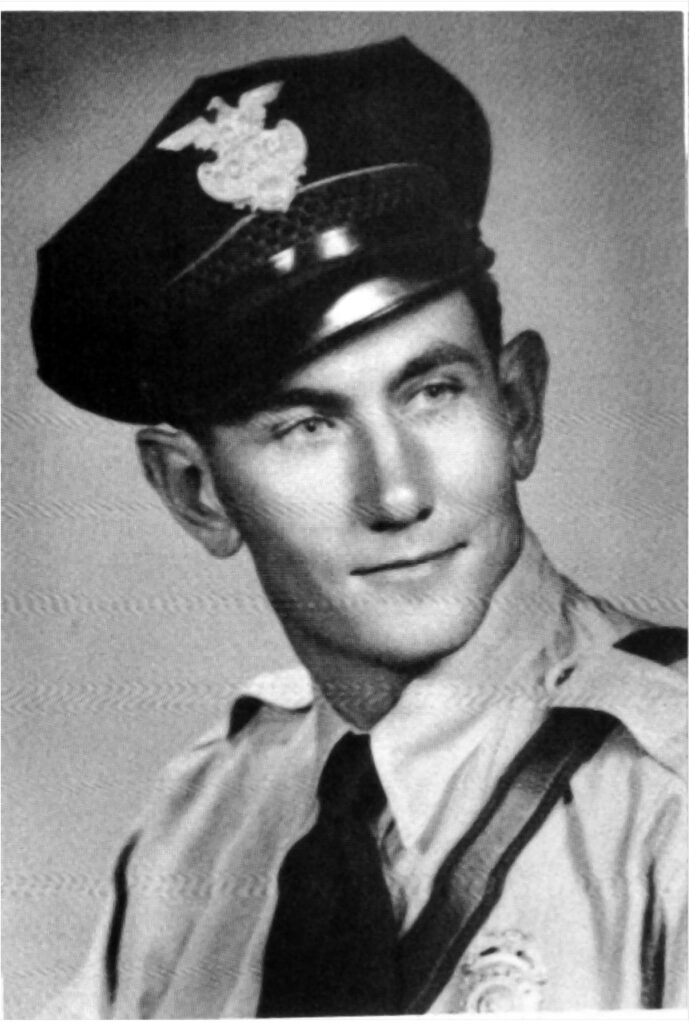
Died in the line of duty: Friday October 10, 1952
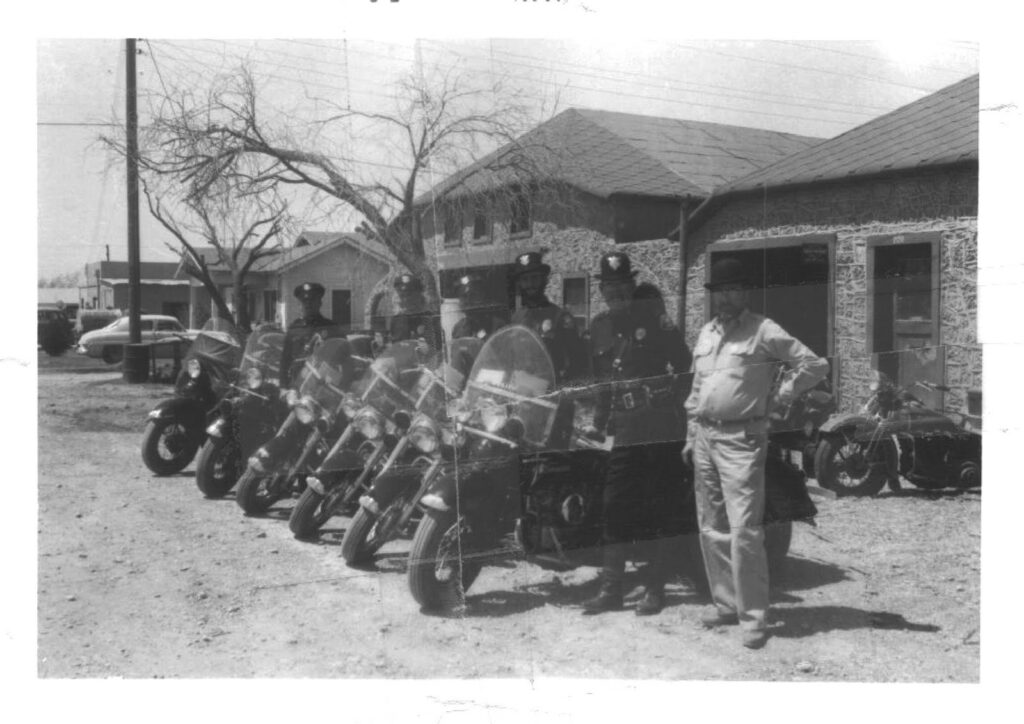
in 1956, note the dirby hats and beards due to Abilene’s 75th Birthday
Celebration
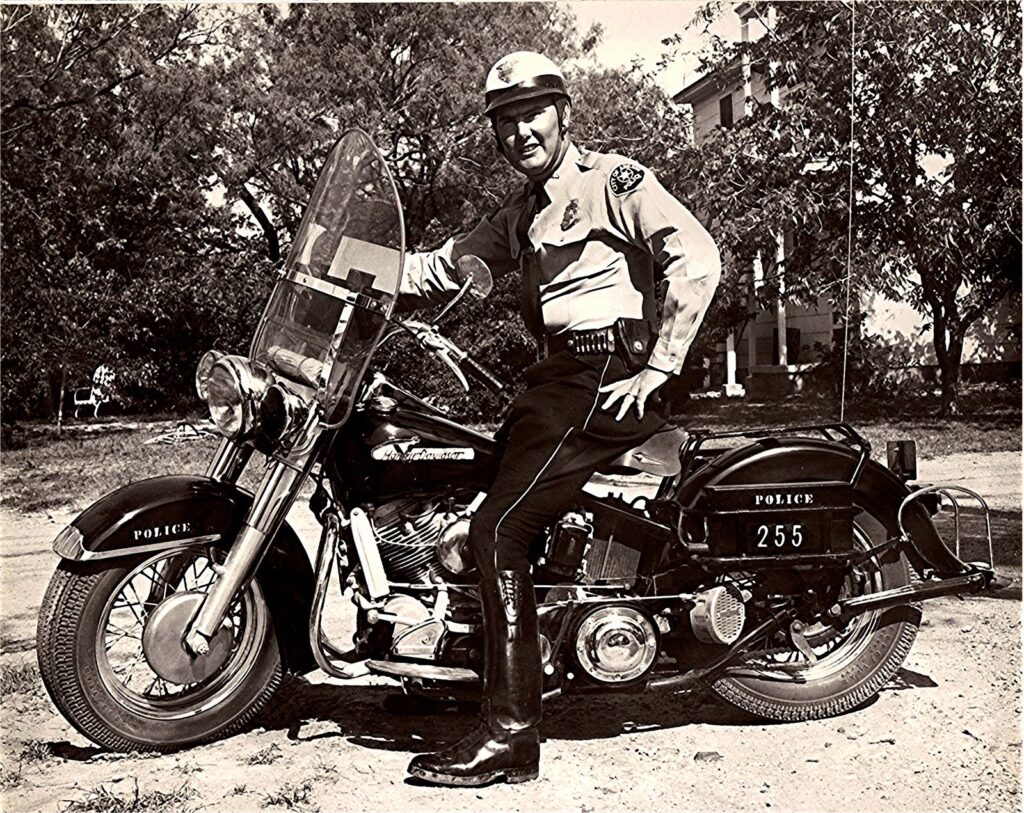
solo motor that I rode. The motor is a few months old in this photo.
This was the 2nd brand new motor to which I was assigned within
a 12 month period. This photo was taken on Reading Street across the
street from where Shirley and I lived at the time. The Photo was taken by
my good friend, Bob Gully who worked for
The Abilene Reporter New
at the time.
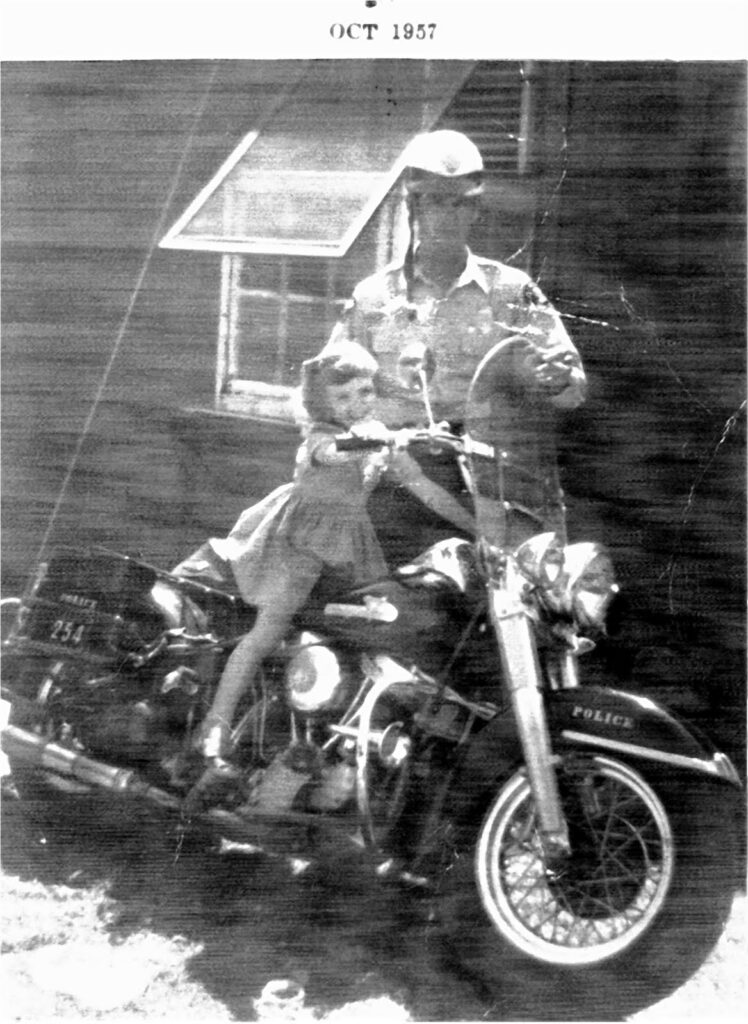
Note Lynn later became a Taylor County Deputy Sheriff Oct. 1957
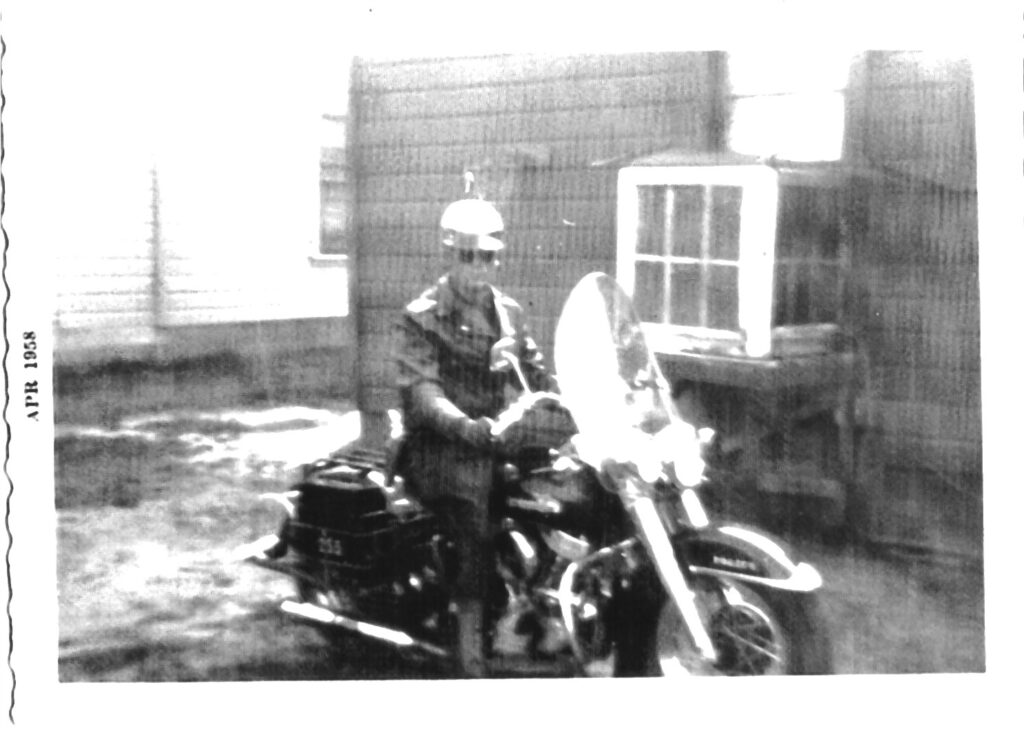
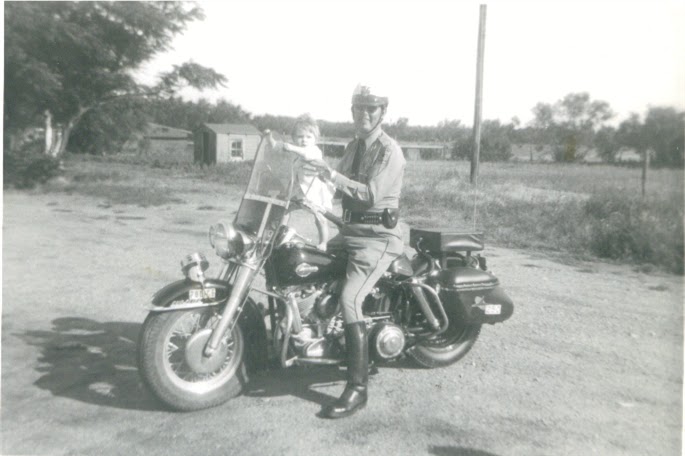
on a H.D. Duo-Glyde that came with saddle bags. Note the radio above
the rear fender. It is side mounted boxes turned on their sides with
a water proof cover over the boxes. Also note front fender mounted Siren
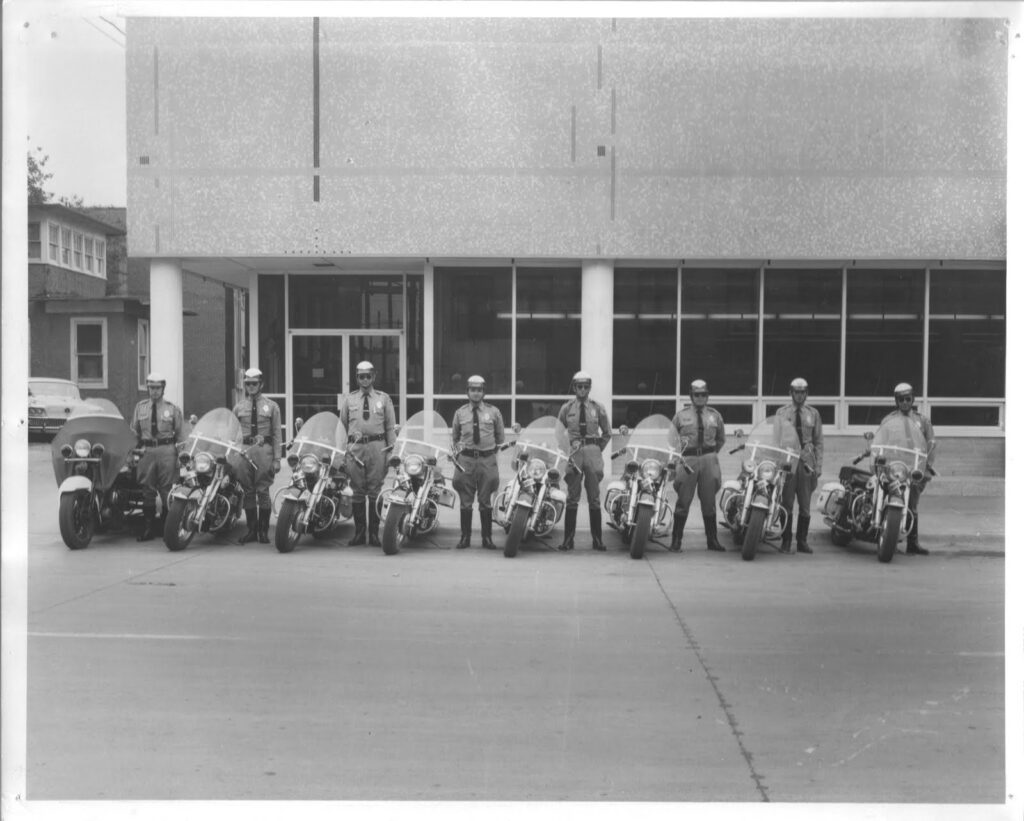

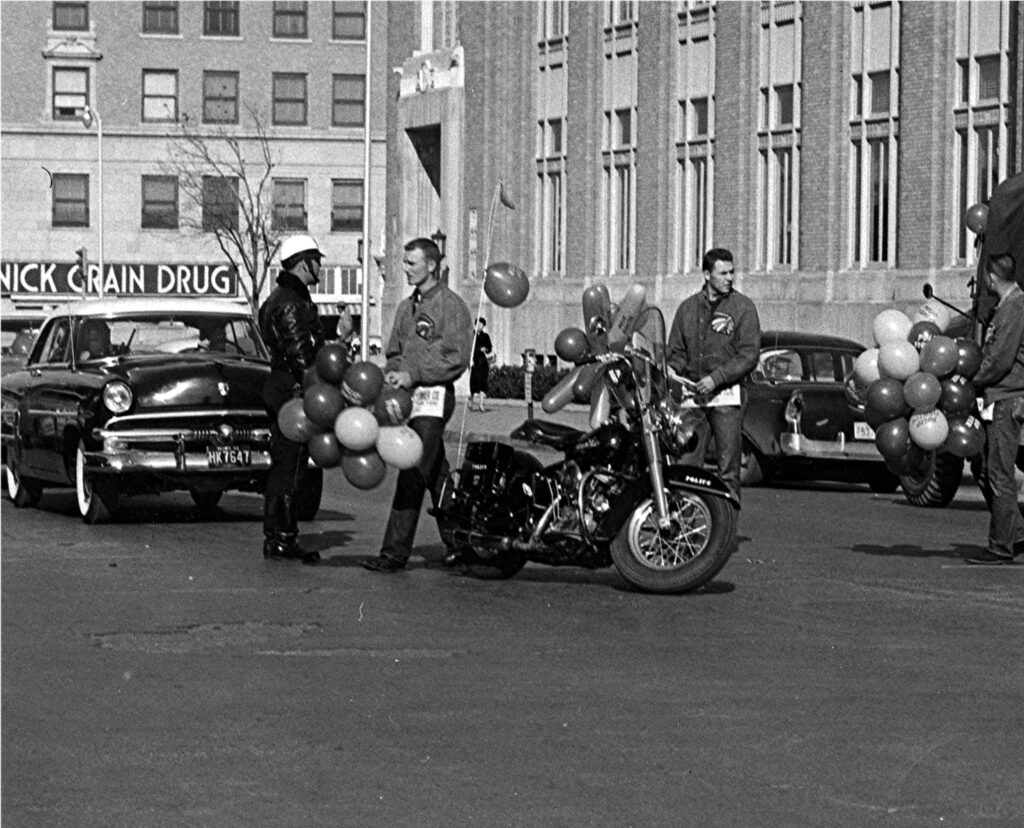
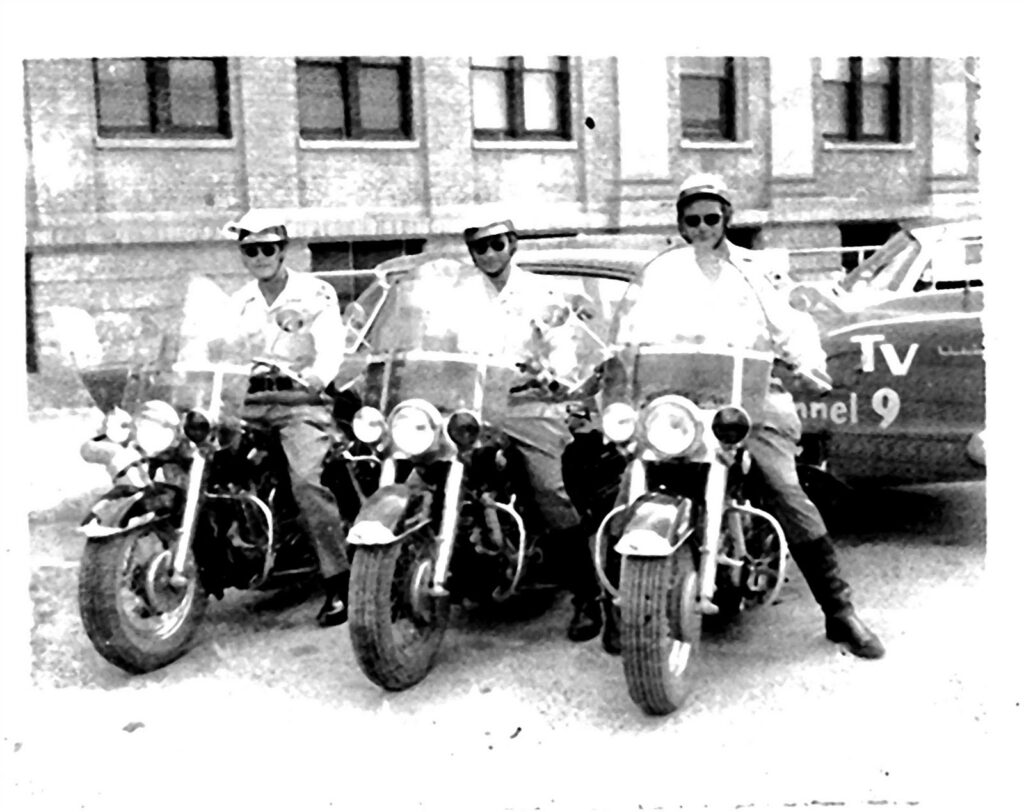
at the old City Hall, North 2nd and Cedar
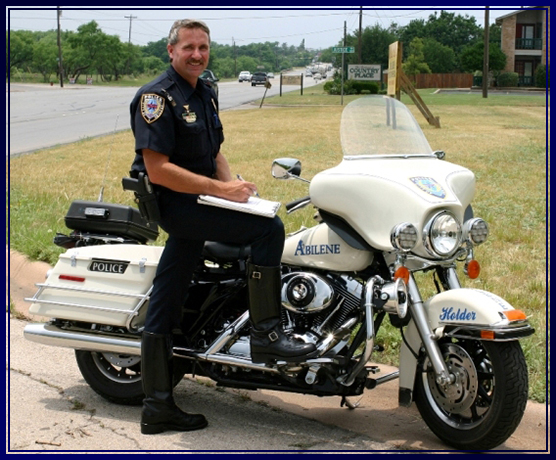
Died in the line of duty: Thursday April 29, 2010
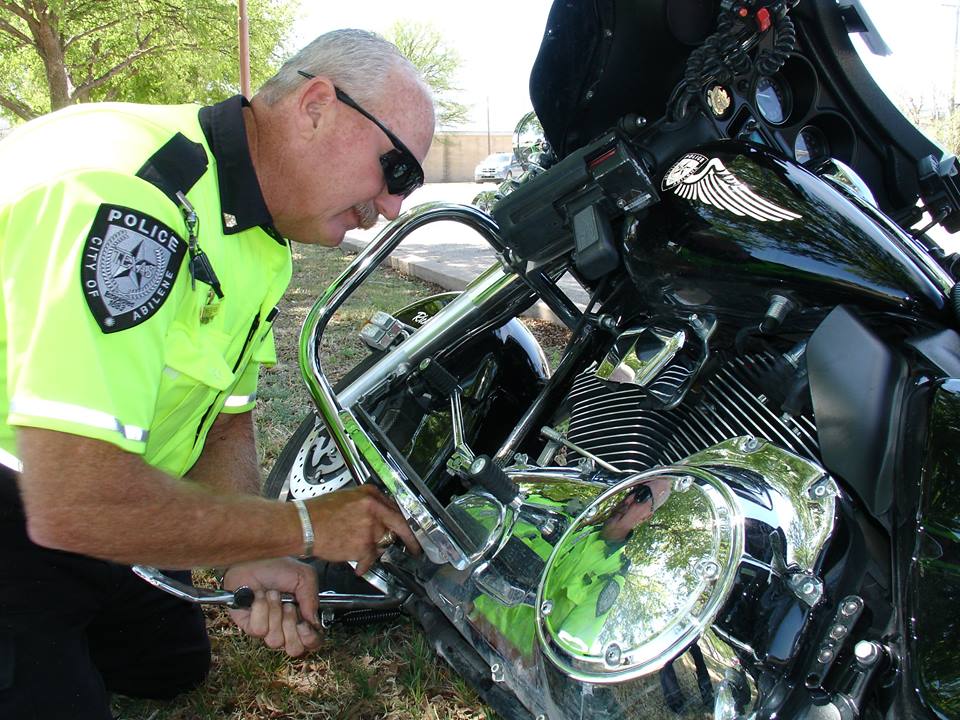

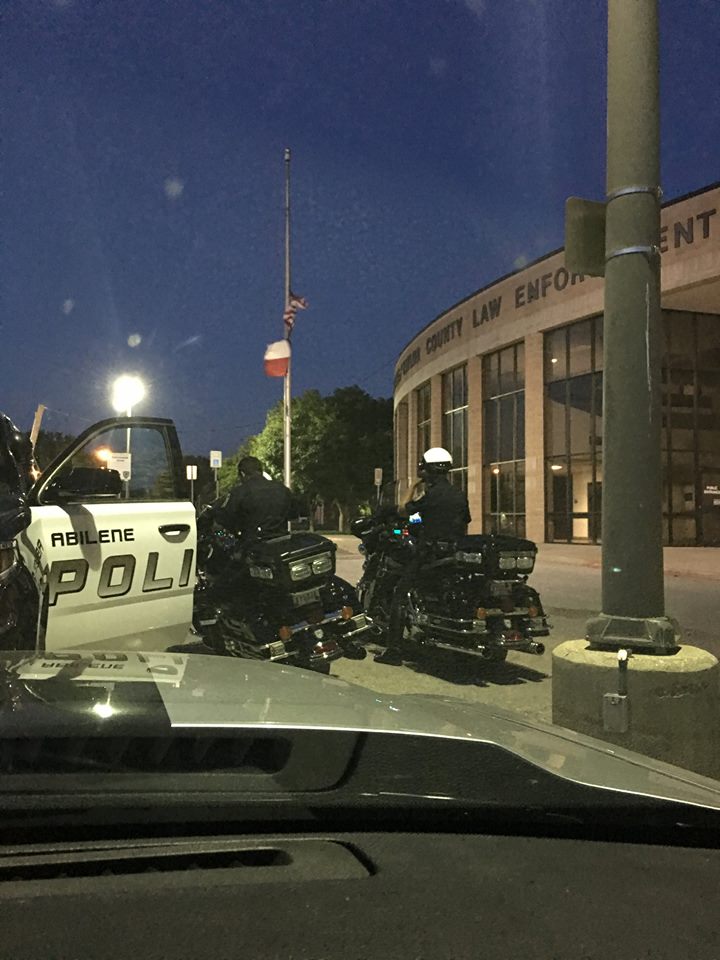
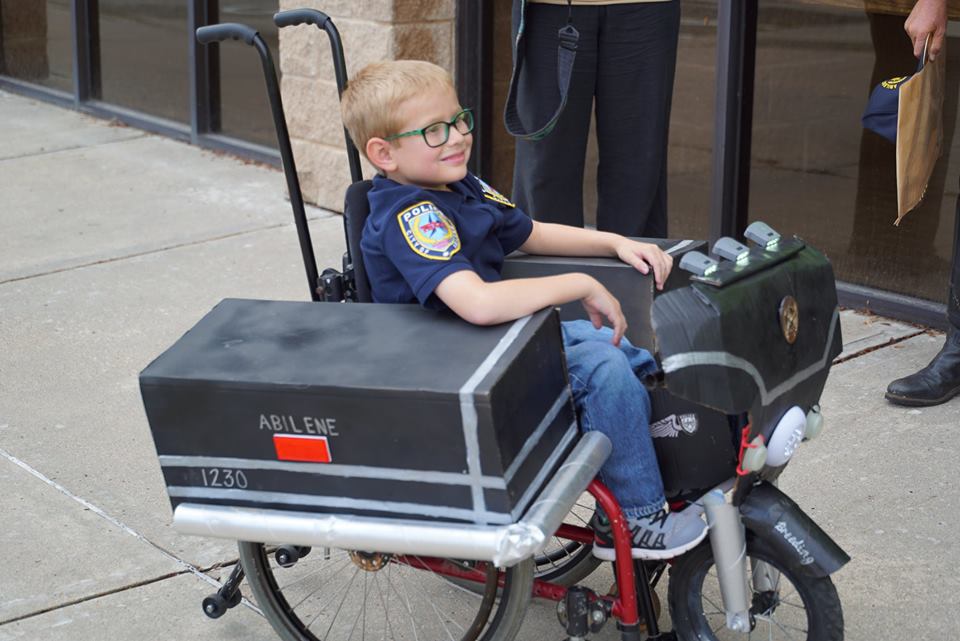
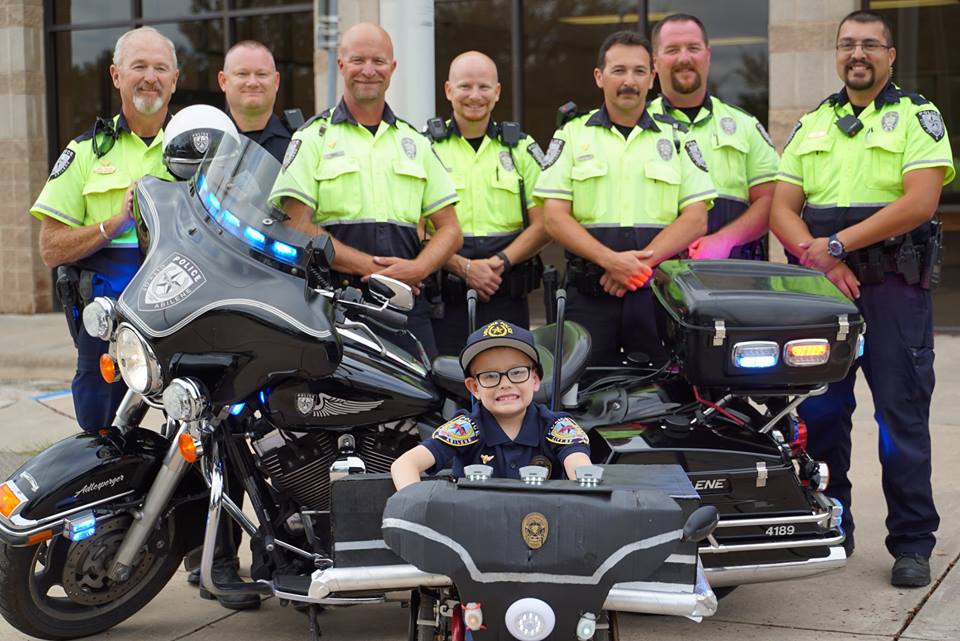
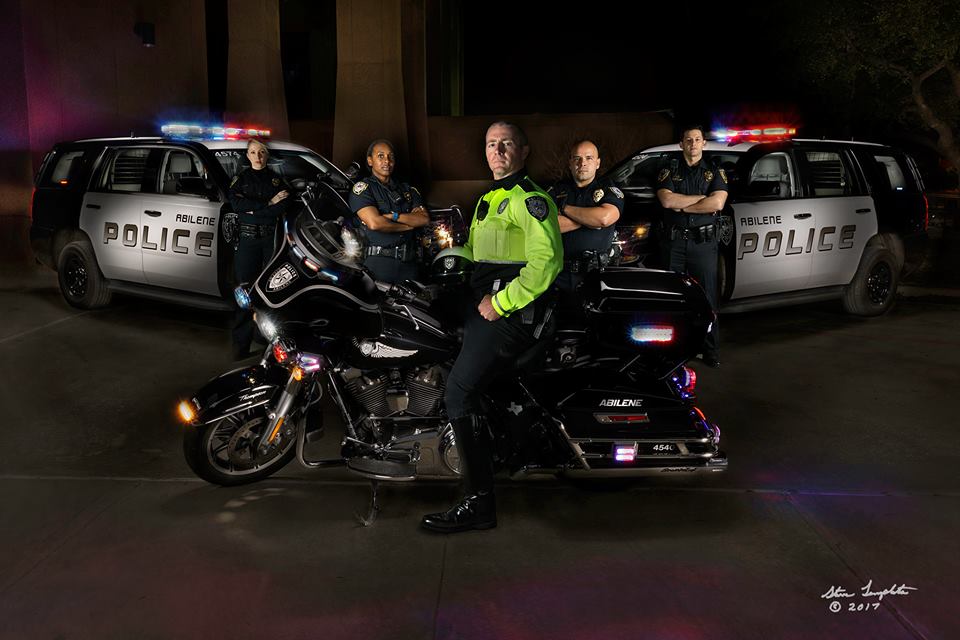
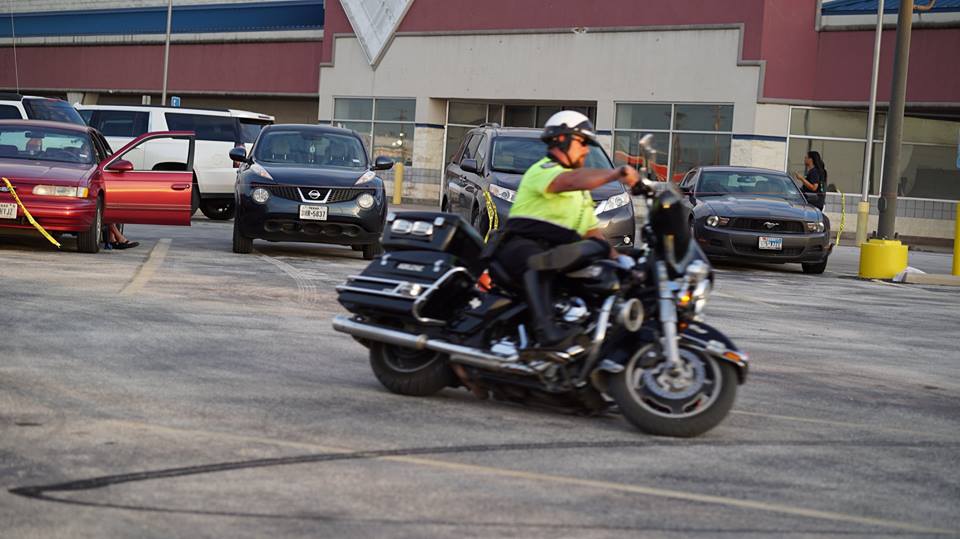
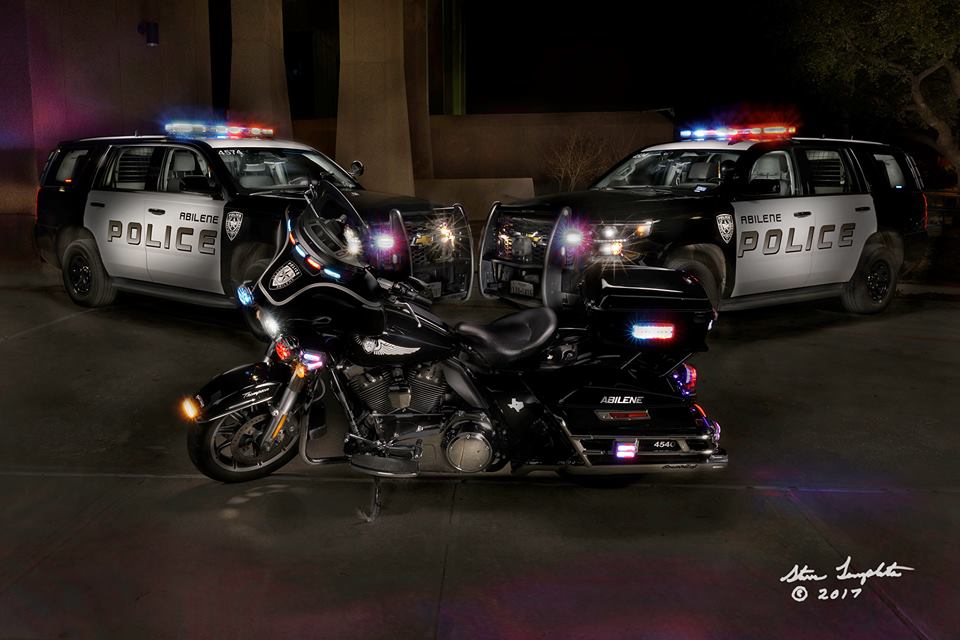
The Abilene Police Blog Reproduced with permission of J. Bryan Wasson’s Wife. Information and Photos provided by the Abilene, TX Police Department.
